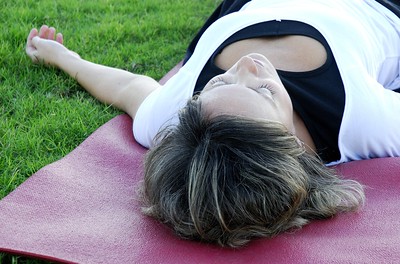
20 Jul The Science of Savasana (Yoga in Hounslow)
Have you ever been in a yoga class and thought to yourself what is the point of me lying here in the Savasana pose?
In this fascinating article by Joni Sweet for Healthline.com we are taken through the myriad benefits of the Savasana pose.
The Science of Savasana: How Rest Can Benefit Any Kind of Workout
You’ll want to start setting aside five minutes after every workout.

Here are some of the biggest advantages of Savasana, and how it can be used as a complement to any exercise.
Savasana relieves physical and mental stress that builds during a workout
Whether you’re doing sun salutations, taking a HIIT class, or cycling, exercise has a profound effect on the body. Your heart beats faster, your body sweats, and your lungs breathe more heavily.
In other words, exercise puts stress on the body — and taking Savasana or meditating after a workout helps bring it back to homeostasis, or your body’s balanced state.
“Your body doesn’t differentiate between stress from running from a tiger, having a long day at work, or a run in the park,” says Dr. Carla Manly, a clinical psychologist and yoga and meditation instructor. “Exercise puts us in that fight-or-flight state. Those situations trigger the body to flood itself with adrenaline and cortisol. The body shuts down all but its critical functions.”
Taking a rest post-workout counteracts those stress responses in the body, she notes.
“Meditation has huge benefits for physical health, such as reduced blood pressure, increased immunity and improved lung function,” says Astor.
When we allow the body to wind down after exercise — rather than bolting to the grocery store or back to the office — it creates a sense of calmness. And studies show that a regular meditation practice can help reduce stress and anxiety for the long termTrusted Source (just like exercise).
Combining the two may help provide even greater stress relief.
Rewarding hard work with Savasana may help you build an exercise habit
Turning exercise into a regular routine can be a challenge. Most of us can come up with an array of excuses to skip the gym. Savasana might one way to turn exercise into a habit.
“Savasana can help people stick to their exercise routines. At our core, we’re animals and we work on a reward system, either consciously or subconsciously. That period of rest is like a built-in reward system,” Manly tells Healthline.
Savasana may help you keep your post-workout high throughout the day
You know that natural high you get after exercise? Savasana might help to prolong your elevated mood long after you’ve stepped off the mat, said Manly.
“If you’re able to really slow it down and enjoy the rest, you can take that relaxation through the next part of your day,” she said. “It lets the body flood with feel good neurochemicals that help you sustain your good mood.”
There’s also long-term mental health benefits from combining mindfulness with exercise. A 2016 studyTrusted Source found that people with clinical depression saw immense improvements in their symptoms when they meditated for 30 minutes before hitting the treadmill twice a week for eight weeks.
Savasana builds resilience we can use in our daily lives
Surprisingly, Savasana is considered one of the most challenging poses in yoga. It’s not easy to lay down, relax the breath, and silence the chatter in the mind. But disciplining the mind and body to meditate after rigorous activity builds resiliency that can be used in other areas of life.
“When we’re able to take that rest, we tend to be less shakable by external events. It gives us inner confidence and well-being,” shares Manly.
Just like you learn to let go of life’s little worries when you’re in Savasana, you also develop the skills to react mindfully during a difficult situation.
Savasana keeps you present and more joyful
How often are you thinking of something other than what you’re doing right now? A 2010 study that gathered iPhone app responses from 2,250 adults worldwide revealed that almost half our thoughts have nothing to do with what’s going on at any given moment.
Upon further analysis, the data also showed that people tended to be less happy when their thoughts did not align with their actions.
Savasana and meditation can help us focus on the here and now, potentially making us feel more joyful throughout our lives, Astor explains.
Next time your classmates start rolling up their mats and darting out of the studio just before Savasana — or you’re tempting to rush back to work after a run — double down on your own meditation.
Here’s how to actively rest after exercise to reap the mental and physical rewards of Savasana.
How to take Savasana
- Set aside 3-10 minutes after your workout. Head to a quiet place you can lay on the ground or sit.
- Lie with your back on the ground with your feet hip-width apart, your arms relaxed alongside your body, and your palms facing up.
- Close your eyes and relax your breathing. Let go of any muscle tension that may have built up during your workout. Try to clear your mind. If thoughts come up, acknowledge them and let them go.
- You may find yourself drifting off to sleep, but try to stay awake and aware of the present moment. The true benefits of Savasana — or any meditation — happen when you approach it with mindfulness and intention.
- When you’re ready to end your Savasana, bring energy back into the body by wiggling your fingers and toes. Roll to your right side, then slowly move into a comfortable seated position.
Source: https://www.healthline.com/health/benefits-savasana-after-any-workout#1

No Comments